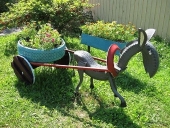












John Daley Bendigo, Australia The Enemy of progress is the hope of a perfect plan
Benefits of rainfall collection https://permies.com/t/88043/benefits-rainfall-collection
GOOD DEBT/ BAD DEBT https://permies.com/t/179218/mortgages-good-debt-bad-debt








John Daley Bendigo, Australia The Enemy of progress is the hope of a perfect plan
Benefits of rainfall collection https://permies.com/t/88043/benefits-rainfall-collection
GOOD DEBT/ BAD DEBT https://permies.com/t/179218/mortgages-good-debt-bad-debt




Bill Ayers wrote:Tys,
Yes, to guarantee the dirt does not fall out the bottoms eventually it is best to plaster over the tires.




John C Daley wrote:I have no idea why cardboard is needed.
I lay the tyres down in columns, screw them together horizontally with roof screws.
Then I fill the wall with any scrap, I have used bottles , rocks and soil.
At the top I have made a mud mixture that can be formed into a water draining cap. The addition of lime or cement in the cap helps.
Am I clear in my description.
Tyres laid in the brick pattern are ok, but on a short wall you get lots of half tyre requirements which is not practical.
I have taken my walls up 6 feet.




John Daley Bendigo, Australia The Enemy of progress is the hope of a perfect plan
Benefits of rainfall collection https://permies.com/t/88043/benefits-rainfall-collection
GOOD DEBT/ BAD DEBT https://permies.com/t/179218/mortgages-good-debt-bad-debt




John C Daley wrote:Where is the proof about toxicity of tyres please?




John Daley Bendigo, Australia The Enemy of progress is the hope of a perfect plan
Benefits of rainfall collection https://permies.com/t/88043/benefits-rainfall-collection
GOOD DEBT/ BAD DEBT https://permies.com/t/179218/mortgages-good-debt-bad-debt

|
All the other guys liked the pretty girls, but I always like you, tiny ad
Learn Permaculture through a little hard work
https://wheaton-labs.com/bootcamp
|





